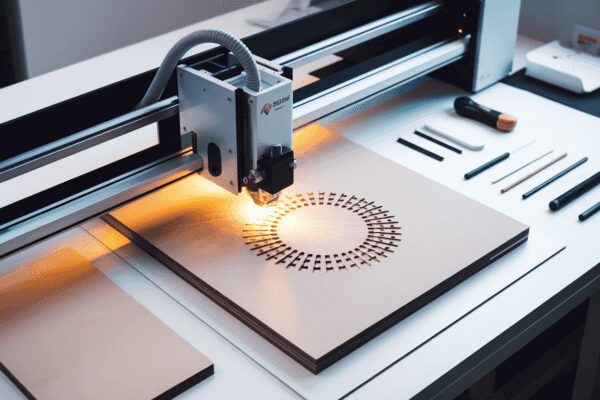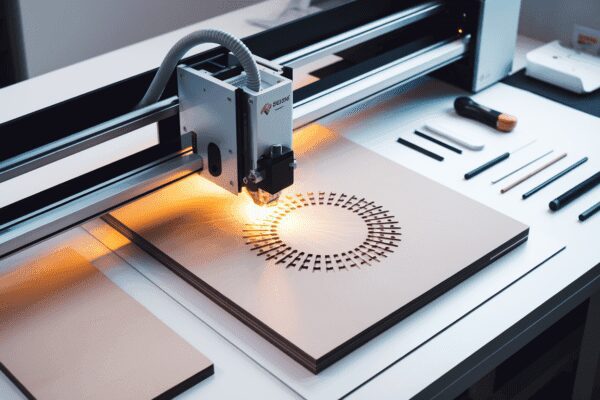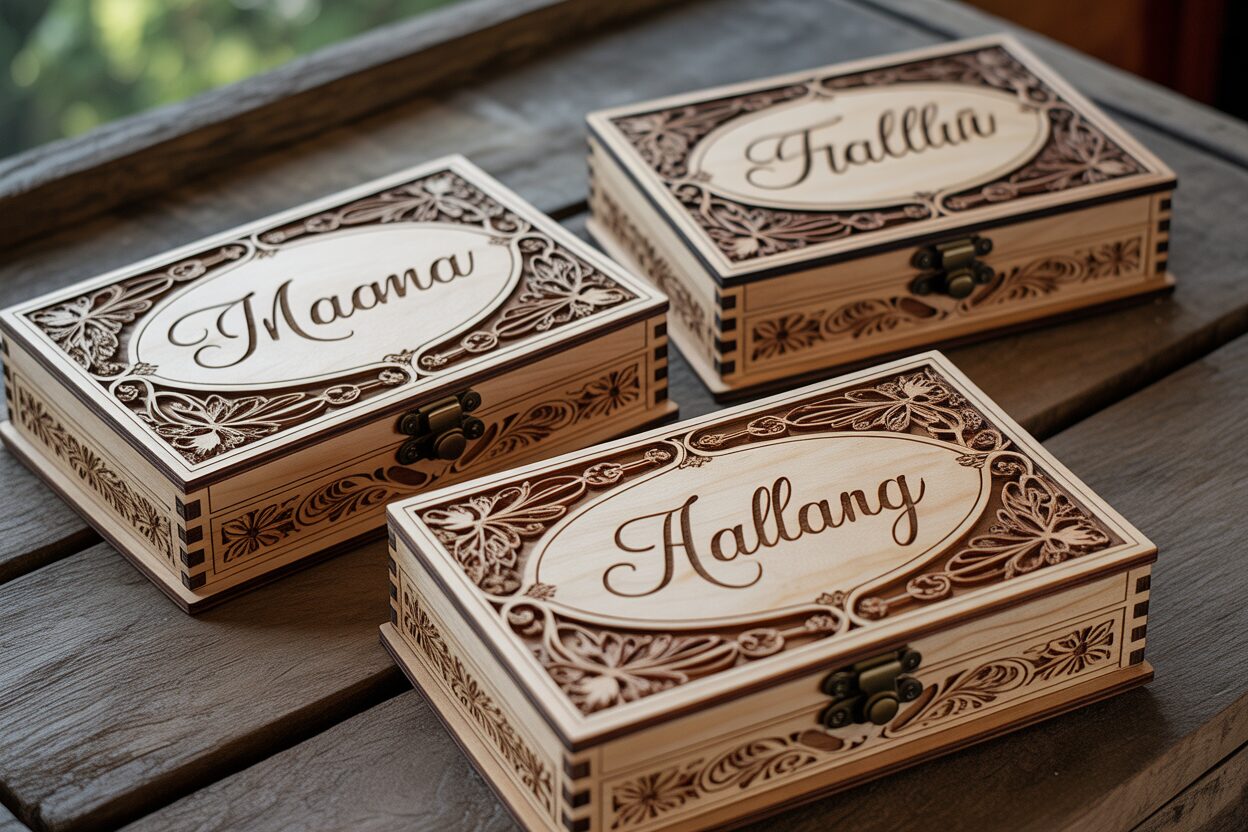Creating Stunning Laser Cut Wood Boxes: Design, Personalization, and Profitable Uses
Estimated reading time: 9 minutes
Key Takeaways
- Choosing the right material (plywood, hardwoods, MDF) and thickness is crucial for the durability, aesthetics, and overall success of laser-cut wood boxes.
- Laser engraving transforms basic wood boxes into highly personalized and unique products, adding significant emotional and market value through custom text, logos, and graphics.
- Effective design files, sourced from vector programs or box generator tools, combined with meticulous wood preparation (e.g., masking, testing settings), are fundamental for precise cuts and clean engravings.
- Profitability can be achieved by targeting markets for personalized gifts, offering innovative packaging solutions for businesses, or selling digital laser-cut design files to other creators.
- Successful marketing involves high-quality visuals, strategic social media engagement, partnering with influencers, and clearly articulating unique selling points to differentiate your products.
Table of Contents
- Designing and Choosing Materials for Laser Cut Wood Boxes
- Personalization and Laser Engraving Techniques for Wood Boxes
- Turning Laser Cut Wood Box Designs into Profitable Products
- Conclusions
Laser cut wood boxes are rapidly gaining popularity for their versatility, beauty, and personalization potential. Whether you’re a craftsperson or entrepreneur, understanding the process of designing, engraving, and selling these boxes will elevate your creativity and boost sales. This article explores everything you need to know to succeed with wooden box projects.
Designing and Choosing Materials for Laser Cut Wood Boxes
Selecting the Right Materials for Laser Cut Wood Boxes
Choosing the ideal material is fundamental to creating stunning laser cut wood boxes that are both beautiful and durable. The material directly impacts laser cutting quality, box aesthetics, and end usability. Plywood is a favorite due to its affordability, widespread availability, stability, and consistent quality. Popular species include birch, maple, and poplar plywood, with 3mm (1/8”) and 6mm (1/4”) thicknesses being the most commonly used for box making. Thinner plywood (around 3mm) works well for delicate or decorative boxes, while thicker plywood (up to 6mm or even 9mm) is appropriate for boxes requiring more durability or load capacity.
For higher-end or visually striking boxes, solid hardwoods such as walnut, cherry, and maple can be laser cut and engraved, offering a richer appearance and a premium hand-feel. However, hardwoods may require more powerful lasers and slower cutting speeds due to higher density. Medium-density fiberboard (MDF) is another material option, prized for its smooth finish and affordable price, but it may lack the natural wood character or strength desired for high-quality products.
- Plywood: Stable, cost-effective, and laser-friendly. Ideal for most laser cut wooden boxes.
- Hardwoods: Luxurious look for specialty or premium boxes; more challenging to cut cleanly.
- MDF: Smooth but less attractive grain, suitable for painted boxes or prototypes.
Thickness Recommendations and Box Strength
Material thickness determines your box’s strength, joint stability, and ability to accept engravings. Most desktop and mid-size laser cutters can cleanly cut material up to 6mm (1/4”). For decorative or lightweight boxes, 3mm plywood is adequate. For children’s toys, keepsake boxes, or organizers expected to bear weight, 6mm or thicker is recommended. For layered or stacked box designs, consider mixing widths for visual and structural interest. Always match design parameters in your cut files with your material’s exact thickness for tight, precise joints.
Finishing Options for Visual Appeal and Durability
Applying a finish enhances the beauty and longevity of your laser cut wood boxes. Popular finishes include clear lacquer or polyurethane for a glossy, protective surface; natural oil finishes like tung or Danish oil for subtle sheen; or tinted stains and colored waxes to accentuate engravings and wood grain. Include a final sanding before finishing, focusing on the laser cut edges to remove soot and burn marks. For a modern or minimalist style, leave some boxes unfinished, especially for light woods or Scandinavian-inspired designs. Always test finishes on a scrap first, especially for engraved surfaces where finish can darken burn marks.
Creating or Sourcing Laser Cut Box Design Files
Effective laser cut design files are essential for precise assembly and an attractive finished product. Use vector-based programs like Adobe Illustrator, Inkscape, or CorelDRAW for drawing and exporting files in SVG, DXF, or AI formats compatible with most lasers. To save time, consider using box generator tools such as MakerCase or Boxes.py, which allow the input of dimensions and material thickness to output box designs with finger joints, living hinges, and interlocking tabs. For custom or premium projects, design tailored features such as intricate lid patterns, cutout windows, and custom compartments within your vector software.
Consider trending styles, such as art deco geometry, mid-century details, layered mandala lids, or minimalistic ornamentation. Integrate company branding or personalized engravings for added value in the market.
Preparing Wood for Successful Laser Cuts and Engravings
Successful laser cutting starts before the machine turns on. Inspect each wood sheet for warping, large knots, or voids, which can disrupt cuts and engravings. Clean surfaces with a tack cloth to remove dust and oils. For a crisp engraving, masking tape or paper mask applied pre-cutting reduces scorched edges and burn residue. Calibrate your laser with a small test square to determine the optimal speed and power settings for your specific wood and thickness to avoid undercutting or charred edges, and log these for repeat exactly. Prepping the wood and your workplace ensures consistent results and reduces post-processing labor, making your production process more efficient and your laser cut wood boxes more visually appealing.
Personalization and Laser Engraving Techniques for Wood Boxes
Transforming Wooden Boxes Through Personalization
Laser engraving is a transformative tool for turning basic laser cut wood boxes into truly unique and meaningful products. Personalization adds emotional value and makes your boxes stand out in a crowded market. Whether meant for gifts, keepsakes, branding, or organizational tools, customization is a powerful selling point. Popular engraving ideas range from names, monograms, heartfelt messages, and significant dates to intricate illustrations, company logos, or even photos converted to vector graphics. For event-focused wooden boxes, consider seasonal patterns or themed artwork that tailor the box for weddings, anniversaries, corporate events, or holidays.
Customizing Text, Logos, and Graphics
Effective customization begins in your design file. Choose clear, legible fonts for text engravings, keeping sizes above 12pt for readability. Script or calligraphic fonts lend an elegant touch, while bold sans-serifs deliver a modern, sleek feel. For logos and graphics, ensure the design is a clean vector to guarantee crisp engraving edges—raster images may blur or lose detail unless converted to high-contrast black-and-white paths. When engraving multiple elements, balance the layout so text, graphics, and empty space work together harmoniously—a well-composed design elevates the perceived quality of the finished laser cut wood box.
For logos and branding, double-check permission to reproduce and adapt logos, particularly for commercial orders. When customizing for clients, always provide proofs or mockups to confirm spelling, alignment, and placement before proceeding to production. This extra step minimizes errors and customer dissatisfaction.
Optimizing Engraving Depth and Laser Settings
The depth and quality of your laser engraving depend on the interplay of speed, power, and frequency settings, as well as the wood species and finish. Shallow engravings (surface marks) are ideal for fine detail or text and provide a more subtle, sophisticated look. Deeper engravings create tactile, high-contrast designs but risk splintering or causing unwanted burn marks if settings aren’t carefully managed. Typically, a higher power setting at faster speeds results in clean, light engravings, while slower speeds deepen the cut.
- Carry out test engravings on scrap material of the same type and finish to finalize your settings without risking the main product.
- Adjust DPI (dots per inch) for the desired level of detail; 250-500 DPI yields crisp results for most graphics.
- Masking the box’s engraving area with low-tack tape before engraving can reduce smoke stains and resin deposits, especially on light woods.
For consistent results across production runs, keep a log of successful laser settings by material and design type, especially if you use a range of wood species for your laser cut wooden boxes.
Avoiding Common Laser Engraving Mistakes
Overburning is a major pitfall in wood engraving—excessive power or slow speeds can char the wood, blur details, and result in a fuzzy or uneven appearance. Always start with recommended settings for your machine and incrementally adjust. Insufficient focus or poorly prepared artwork can cause incomplete engravings or double lines. Ensure your box surface is flat and level for a consistent result, and periodically clean your machine’s optics to maintain clarity and power.
Designwise, overcrowding the engraving area or placing features too close to edges can lead to unattractive outcomes or weak spots in the box structure. Maintaining adequate margins enhances both visibility and durability.
Adapting Designs for Maximum Impact
Personalization pushes the creative boundaries of laser cut wood boxes. Adapt your engravings to the recipient’s style or your target market by tracking trends—botanical mandalas, minimalist flourishes, geometric patterns, or cultural motifs are all in high demand. For multi-purpose or retail boxes, offer template-based layouts that can easily be customized per customer, making your process efficient and scalable. Experiment with layering engraved pieces, selective color-filling of engravings, or combining cut-through elements with engraved features for a three-dimensional effect, maximizing the perceived value and appeal of your custom wooden boxes.
Turning Laser Cut Wood Box Designs into Profitable Products
Capitalizing on the Value of Laser Cut Wood Box Creations
Transforming your laser cut wood box designs into profitable products requires a deliberate approach that goes beyond precision cutting and engraving. With the rising popularity of personalized gifts, sustainable packaging, and bespoke home décor, hand-crafted wooden boxes offer a compelling value proposition. The right strategies can elevate your creations into best-selling items, whether you’re focusing on customized wood gifts or developing unique packaging for retailers.
Personalized Gifts and Keepsake Boxes: Meeting Modern Demand
The demand for personalized wooden keepsake boxes continues to surge in both the online and offline gift markets. Consumers gravitate toward meaningful, customized items for weddings, anniversaries, birthdays, and life events. Offering laser cut wooden boxes with personalized engraving—names, special dates, quotes, or custom graphics—instantly increases their perceived and actual value. Niche down your offerings by targeting popular occasions or themes, such as memory boxes for new parents, proposal ring boxes, or branded corporate gift boxes.
Stand out by leveraging the tactile beauty of wood, intricate design work achievable through laser cutting, and the emotional connection that personalized products offer. Bundling products—such as gift sets that include small items inside the box—can further elevate your sales potential.
Innovative Packaging Ideas for Businesses
Wooden boxes are increasingly sought after by retailers and brands as eco-friendly and luxurious packaging solutions for high-end goods. Collaborate with businesses to create branded, reusable laser cut wood boxes for jewelry, cosmetics, food gifts, or product launches. Highlight the advantages of your designs: sustainable materials, reusability, precision craftsmanship, and the ability to add custom branding for corporate clients.
Design functional boxes with thoughtful compartments or magnetic closures that add to the product’s value. Use laser engraving to integrate logos, product information, or artistic embellishments directly onto the box. These unique selling points help position your laser cut wooden boxes as a significant upgrade from ordinary packaging, opening opportunities for bulk or B2B sales.
Selling Digital Laser Cut Design Files
If you have a knack for digital design, monetizing your laser cut box templates can open new revenue streams. Build a catalog of downloadable design files—SVG, DXF, or AI—targeted at hobbyists, crafters, or other laser business owners. Ensure your files are cleanly structured and easy to modify for different wood thicknesses or engraving requirements. Offer a range of styles, from minimalist organizers to ornate jewelry boxes, and pair them with clear assembly instructions.
Promoting your digital products through marketplaces like Etsy, Creative Market, or niche sites for laser cut files expands your brand reach and provides passive income as your designs gain popularity.
Marketing and Distinguishing Your Laser Cut Wood Boxes
Effectively marketing your wooden keepsake box creations relies on compelling presentation and storytelling. Invest in high-quality photography and video—highlight product details, demonstrate uses, and capture the engraving’s depth and character. Share the design and crafting process through stories or behind-the-scenes content to foster a connection with your audience.
- Engage with potential customers on social media platforms popular among crafters and gift buyers, such as Instagram, Pinterest, or TikTok.
- Partner with influencers or bloggers for product showcases and reviews.
- Leverage seasonal trends—launch themed collections around holidays, graduations, or weddings to generate timely demand.
- Offer customization and quick turnaround for personalized orders to appeal to last-minute gift buyers.
Identify your unique selling points: Are your laser cut wooden boxes eco-friendly? Do you offer rare wood types or exclusive engraving styles? Is your personalization process faster, or your packaging more memorable than competitors? Clearly articulate these advantages across your listings and marketing materials to establish a distinct market presence.
With careful attention to style, evolving trends, and the practical needs of your target market, your laser cut wood box creations can become both stunning keepsakes and profitable products in a competitive marketplace.
Conclusions
Laser cut wood boxes offer endless artistic and business opportunities, combining creative design with practical application. By mastering both the technical and creative aspects, you can offer unique, sought-after products to discerning customers. Explore design ideas, master the tools, and watch your skills and sales grow.
FAQ
Q: What are the best materials for laser-cut wood boxes?
Interested in more Boxes? Check out our Boxes laser file designs: Click here!
A: The best materials are plywood (especially birch, maple, poplar in 3mm or 6mm thicknesses) for its affordability and stability, solid hardwoods (like walnut, cherry, maple) for a premium look, and MDF for smooth finishes or prototypes.
Q: How can I personalize laser-cut wood boxes?
A: Personalization can be achieved through laser engraving names, monograms, dates, heartfelt messages, intricate illustrations, company logos, or photos. You can also adapt designs for specific events or target markets by tracking trends and offering template-based layouts.
Q: What are common laser engraving mistakes to avoid?
A: Avoid overburning (excessive power or slow speeds), which chars wood and blurs details. Ensure proper focus, clean artwork, and a flat surface. Also, avoid overcrowding designs or placing features too close to edges to maintain structural integrity and visual appeal.
Q: How can I make my laser-cut wood boxes profitable?
A: Focus on personalized gifts for occasions like weddings or birthdays, offer innovative and eco-friendly packaging solutions for businesses, or sell digital design files to other crafters. Effective marketing with high-quality visuals and highlighting unique selling points is also crucial.
Q: What software is best for designing laser-cut box files?
A: Vector-based programs like Adobe Illustrator, Inkscape, or CorelDRAW are ideal for creating design files. For quicker box designs with specific joints, consider using box generator tools such as MakerCase or Boxes.py.
Q: How thick should the wood be for laser-cut boxes?
A: Most desktop and mid-size laser cutters can cut up to 6mm (1/4”) thick material. 3mm plywood is suitable for decorative or lightweight boxes, while 6mm or thicker is recommended for items requiring more durability, like keepsake boxes or children’s toys.


Subscribe to Our Newsletter
And enjoy FREE Download Files, SALE Alerts and Inspiring TIPS


A Comprehensive Guide to Crafting Engraved Slate Coasters
A Comprehensive Guide to Laser Engraving Slate Coasters
A Guide to Crafting a Personalized Charcuterie Board
Valentine Love Captions: 6 Charcuterie Board Engraving Files…
$8.00Original price was: $8.00.$5.60Current price is: $5.60.(30% off)
Bee and Honey Jar Charcuterie Board Engraving File | PNG Download #007…
$4.00Original price was: $4.00.$3.20Current price is: $3.20.(20% off)
Charcuterie Board Engraving File – Wine & Grapes 3D Illusion…
$4.00Original price was: $4.00.$3.00Current price is: $3.00.(25% off)
American Eagle Flag Laser Engraving File for Charcuterie & Cutting…
$4.00Original price was: $4.00.$2.80Current price is: $2.80.(30% off)